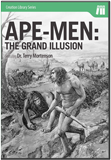
The Return of the Hobbits
True nature of Indonesian “hobbits” in the news once again
The debate over “hobbit” remains found in an Indonesian island cave shows no signs of slowing. Creating news this time is a new theory published in Proceedings of the Royal Society B, BBC News reports.
The tiny human remains, nicknamed “hobbits” in reference to the book and film trilogy The Lord of the Rings, were found in the Liang Bua cave on the island of Flores (Indonesia) back in 2004. Since then, four different views have been propagated:
- The hobbits were Pygmies—“true” (modern) humans, but quite small.
- The hobbits were not Pygmies, but were nonetheless true humans; instead, they were diseased with microcephaly, a condition resulting in abnormally small skeletons.
- The hobbits were a separate species from modern humans—a diminutive ancestor (or “cousin”) called Homo floresiensis.
Plus, the view taken in the recently published paper:
- The hobbits were true humans but did not grow to normal size because of environmental factors (specifically, insufficient nutrition).
We covered the original story—and the developments to it—in our News to Note web feature and in other web articles (see below). First was the declaration of a new “human ancestor” (which we refuted); next a team announced that the hobbits were true humans with microcephaly; since then, groups have fought back and forth between the “unique species” viewpoint, the “true humans with some condition/disease” viewpoint, and the “true humans, simply small like Pygmies” viewpoint.
One example of the back-and-forth madness was a study led by Smithsonian Institution paleontologist Matthew Tocheri that argued that the hobbit wrist bones were more similar to gorillas and chimps than to modern humans, thus showing the hobbits to be a human ancestor. In response, such scientists as biological anthropology curator Robert Martin of Chicago’s Field Museum argued that Tocheri’s study did not compare the hobbits’ wrist bones to those of modern humans who have microcephaly (which can cause deformations throughout the skeletal system, including in the wrists). At this rate, it appears as though the debate will continue for quite a while!
The latest twist
What about the latest news? An Australian team led by Peter Obendorf of Melbourne’s RMIT University is arguing that the hobbits were indeed modern humans, but that their poor nutrition was responsible for their small size. Obendorf explained that severe iodine deficiency during pregnancy can cause dwarfism, leaving an otherwise normal human shorter than a meter (3.3 ft) tall. The hobbits’ skulls would have only held a brain the size of chimpanzee’s.
Obendorf’s team came to the conclusion while studying images of the Flores fossils’ skulls, then comparing those skulls’ anatomical features to those of museum specimens of humans that suffered congenital hypothyroidism.
However, Peter Brown of Armidale, Australia’s University of New England, who was on the team that discovered the remains, considers Obendorf’s team’s hypothesis “sheer speculation,” even going so far as to accuse the Obendorf’s team of having “little and no experience with fossil hominids.” But Jeremy Austin, deputy director of Adelaide University’s Australian Centre for Ancient DNA, says it may take an analysis of genetic data to sort out the exact status of the hobbits. For now, however, such a prospect is unlikely given “poor preservation of the Liang Bua material and extensive contamination by modern human DNA of material recovered from the site.”
What’s our take on the hobbits?
Starting with the biblical worldview, there are only three options for what the hobbits could be:
- The hobbits were a nonhuman species created by God (part of one of the ape kinds, that is) and therefore were neither made in His image nor were they either ancestors or cousins of modern humans.
- The hobbits were true humans, but a disease, poor nutrition, or some other Curse-caused factor (Genesis 3) prevented them from achieving a more normal size.
- The hobbits were true humans whose small stature represented some of the created variation God designed in Adam and Eve.
Let’s take a look of each of these possibilities in turn. First, were the hobbits some type of ape? If all we had to go on were the fossils, we would never be able to say for sure. We weren’t there to actually observe how much intelligence the hobbits exhibited, for instance; the intelligence of a creature now fossilized can only be indirectly approximated.
One of the ways intelligence can be indirectly approximated, however, is by looking at the presumed habitat of a fossil (in this case, for signs of intelligence). When it comes to the Flores hobbits, the Liang Bua cave also housed stone tools and signs of hunting and the controlled use of fire. These are all clear signs of human intelligence—patterns of behavior that distinguish humans from apes.
Furthermore, there is an incentive for the fossils’ finders to interpret the find as a human ancestor rather than “simply” a variation of modern humans. Writing on the find, creationist anthropologist Marvin Lubenow explained:
Because of the tremendous fascination the public has regarding our ancestry, a fossil hunter who finds a “human” fossil that seems to be unique receives much fame and fortune. . . . Thus, there is great incentive to be the first to find something new. . . . This has been the history of human fossil hunting, and it appears to be what is going on with the hobbits. However, after sober reflection by evolutionists, the claims for these fossils are becoming less sensational.1
Simply put, although it would be possible (within the biblical worldview) for the hobbits to be an undiscovered species of ape, given all the evidence, the hobbits were definitely human.
Second, were the hobbits true humans, but suffering from some disease? Obviously, Obendorf’s team believes so after its comparison; in addition to congenital hypothyroidism, a condition called microcephaly has been postulated as the cause of the small-headed and small-bodied hobbits.
Microcephaly or some other disease or condition (environmental, genetic, or both)—that is, a factor caused by the Curse—helps explain why, in addition to the small stature of the hobbits, bones throughout their skeletons were deformed in places. This also explains why Obendorf’s team found similarities between the hobbits’ skulls and the microcephalic skulls they compared them to.
Thus, diseased or otherwise unhealthy humans—but true, “modern” humans nonetheless—remains a definite possibility that has been corroborated by some of the evidence.
Finally, what of the third possibility: that these hobbits were healthy humans whose genes simply restricted them to small size, just like the fully human Pygmy peoples who live in central Africa? Again, this isn’t such a strange possibility; there are thousands of humans of abnormally small stature living today, just as there are thousands of humans of abnormally large stature. The Bible speaks of giants; why not also those much shorter than average? But regardless of their stature, all people are descendants of Adam, created in the image of God—which also explains the hobbits’ apparent use of fire, stone tools, and hunting.
In other words, instead of their small size being a factor of the Curse (through disease, malnutrition, or something else), their small size would have been a built-in feature from creation: genetic diversity, just as is programmed in humans for skin, hair, and eye color (for example).
Conclusion
Regardless of what features the hobbits’ skeletons have, AiG’s in-house anatomist, Dr. Dave Menton, reminds us of the role of interpretive frameworks in analyzing evidence:
I suspect a few more skeletal features or anomalies will yet be found and be interpreted one way or another. Observer bias will always reign supreme in the interpretation of this and other “hominids.” It’s really all very simple—God didn’t make any apemen.
Wearing evolutionist lenses, the evolutionists’ propaganda weaves a continuous lineage from amoeba to man that’s only called flawed when a new transitional form needs to be squeezed in to fill a previously unacknowledged gap.
Considering the skeletal deformities, however, it appears the second possibility—true humans kept small because of disease or malnutrition—is the most likely. But as always, we remind readers that fossils never tell the full story, and we can only make educated guesses—extrapolations into the past—based on what we find in the present.
When it comes to alleged human ancestors, evolutionists are fond of promoting artists’ renderings that show hairy, slouched-over, speechless apemen behaving like troglodytes. However, hair and leopard-print togas are rarely and never fossilized, respectively. Evolutionists need transitional forms between modern humans and the hypothetical common ancestor of apes and humans—transitional forms that only exist in evolutionists’ minds, not the fossil record.
Starting with the biblical worldview, it becomes clear that the hominid fossils we unearth are—time and time again—either slight variations of modern humans (such as Neanderthals who hunted, used tools, made art and fire, and buried their dead) or simply extinct apes (such as australopithecines, who would look to any modern observer like another type of chimpanzee). Wearing evolutionist lenses, the evolutionists’ propaganda weaves a continuous lineage from amoeba to man that’s only called flawed when a new transitional form needs to be squeezed in to fill a previously unacknowledged gap. Wearing biblical lenses, however, we see how all the animal types produce “after their kind”—with variation, yes, but without changing from one kind of animal into another. Humans are no different in this regard, and just as Genesis dictates, while there is much variation among mankind, we are nonetheless all produced in God’s image, all descendants of the First Adam, and all in need of the Last Adam—Jesus Christ—for salvation.
Footnotes
- Marvin L. Lubenow, “Hobbits” were real!, September 13, 2006.
Recommended Resources

Answers in Genesis is an apologetics ministry, dedicated to helping Christians defend their faith and proclaim the good news of Jesus Christ.
- Customer Service 800.778.3390
- © 2025 Answers in Genesis



